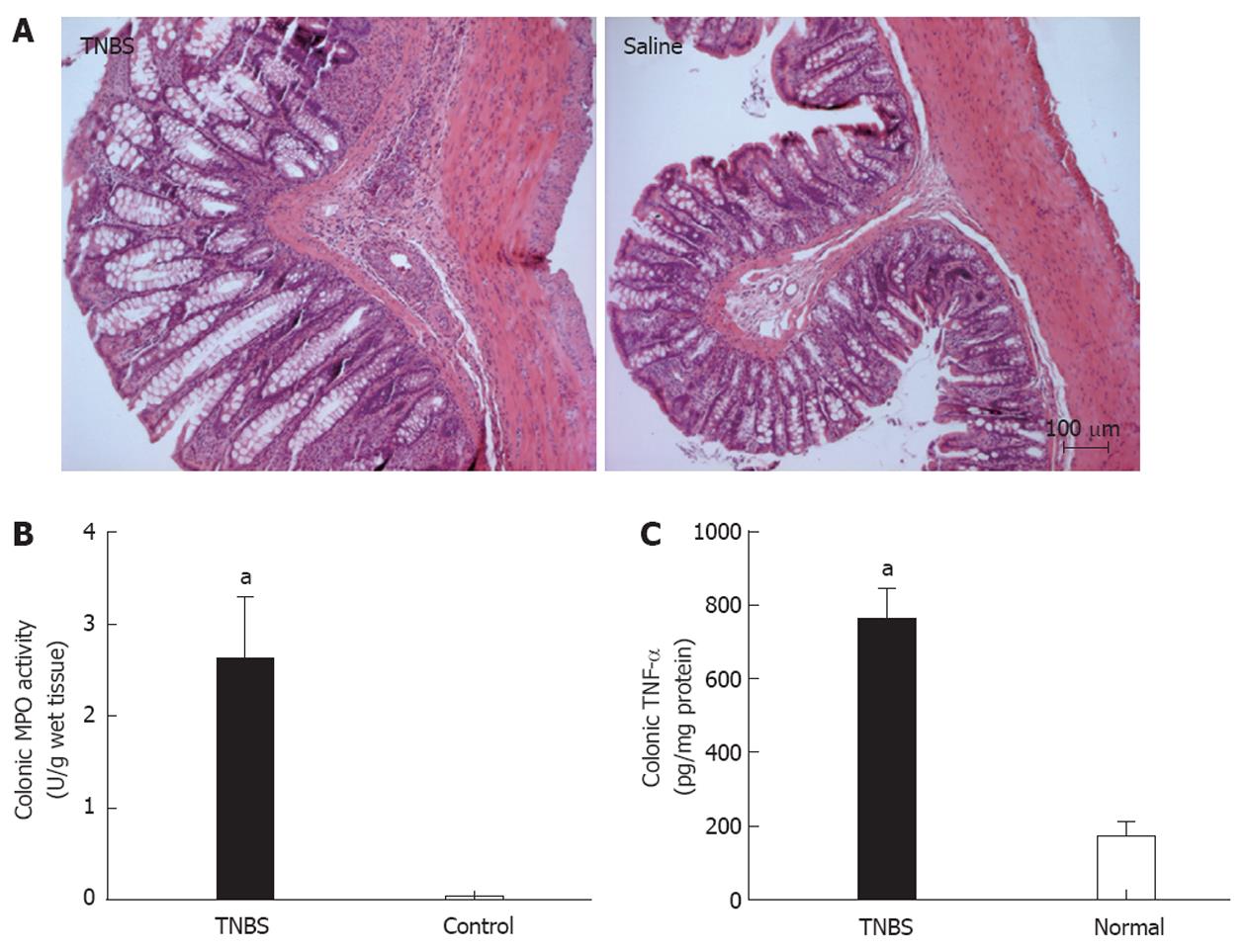Copyright
©2012 Baishideng Publishing Group Co.
World J Gastroenterol. Jun 21, 2012; 18(23): 2914-2928
Published online Jun 21, 2012. doi: 10.3748/wjg.v18.i23.2914
Published online Jun 21, 2012. doi: 10.3748/wjg.v18.i23.2914
Figure 1 The establishment of colitis in trinitrobenzene sulfonic acid rats.
Representative hematoxylin and eosin microscopic photos of the colon tissue (A) revealed inflammation in the sub-mucosa layer of trinitrobenzene sulfonic acid (TNBS) rats; measurement of myeloperoxidase (MPO) activity in wet colon tissue (B, 2.61 ± 2.47 vs 0.03 ± 0.01) and tumor necrosis factor-α (TNF-α) level in colonic total protein (C, 759.80 ± 81.07 vs 174.00 ± 31.92) revealed significantly elevated MPO activity and TNF-α level in TNBS treated group in comparison with saline control group. aP < 0.05 vs saline group.
Figure 2 Representative examples of the silver-stained two-dimensional electrophoresis gels show expression maps of proteins in dorsal root ganglia (A) and spinal cord (B) of trinitrobenzene sulfonic acid colitis group and saline control groups.
TNBS: Trinitrobenzene sulfonic acid; DRG: Dorsal root ganglia; Gstp1: Glutathione S-transferase P; Sod2: Superoxide dismutase; Ndufv2: NADH dehydrogenase (ubiquinone) flavoprotein 2; Ndufb10: NADH dehydrogenase (ubiquinone) 1 β subcomplex 10; Fh1: Fumarate hydratase; Psat1: Phosphoserine aminotransferase; Kctd12: Potassium channel tetramerisation domain containing protein 12; Vdac2: Voltage-dependent anion-selective channel protein 2; Ywhae: The 14-3-3 protein epsilon; Tst: Thiosulfate sulfurtransferase; Hspa8: Heat shock cognate 71 kDa protein.
Figure 3 Immunoblotting analyses to validate the differential expression of proteasome subunit α type-1 (A, 0.
53 ± 0.14 vs 1.81 ± 0.53) and potassium channel tetramerisation domain containing protein 12 (B, 1.21 ± 0.20 vs 0.56 ± 0.07) between trinitrobenzene sulfonic acid treated group and saline control group. The relative expression ratio standardized to β-actin. aP < 0.05 vs saline group. TNBS: Trinitrobenzene sulfonic acid; Psma1: Proteasome subunit α type-1; Kctd12: Potassium channel tetramerisation domain containing protein 12.
Figure 4 Schematic drawing summarizes the major findings that might associate with pathophysiological changes in rat nervous system caused by trinitrobenzene sulfonic acid-induced colitis.
TNBS: Trinitrobenzene sulfonic acid; DRG: Dorsal root ganglia; Hnrnpa2b1: Heterogeneous nuclear ribonucleoproteins A2/B1; Gstp1: Glutathione S-transferase P; Prdx1: Peroxiredoxin-1; Sod2: Superoxide dismutase; Lmna: Lamin C2; Aldoa: Aldolase A; Aldoc: Aldolase C; Ckmt1: Creatine kinase, mitochondrial 1, ubiquitous; Ckm: Creatine kinase M-type; Ndufv2: NADH dehydrogenase (ubiquinone) flavoprotein 2; Ndufb10: NADH dehydrogenase (ubiquinone) 1 β subcomplex 10; Oxct1 succinyl-CoA: 3-ketoacid-coenzyme A transferase 1; Fh1: Fumarate hydratase; Mdh2: Malate dehydrogenase; Psat1: Phosphoserine aminotransferase; Cap1: Cyclase-associated protein 1; Kctd12: Potassium channel tetramerisation domain containing protein 12; Vdac2: Voltage-dependent anion-selective channel protein 2; Ywhae: The 14-3-3 protein epsilon; Tst: Thiosulfate sulfurtransferase; Stip1: Stress-induced phosphoprotein 1; Hspa8: heat shock cognate 71 kDa protein.
- Citation: Zhang XJ, Leung FP, Hsiao WW, Tan S, Li S, Xu HX, Sung JJ, Bian ZX. Proteome profiling of spinal cord and dorsal root ganglia in rats with trinitrobenzene sulfonic acid-induced colitis. World J Gastroenterol 2012; 18(23): 2914-2928
- URL: https://www.wjgnet.com/1007-9327/full/v18/i23/2914.htm
- DOI: https://dx.doi.org/10.3748/wjg.v18.i23.2914












